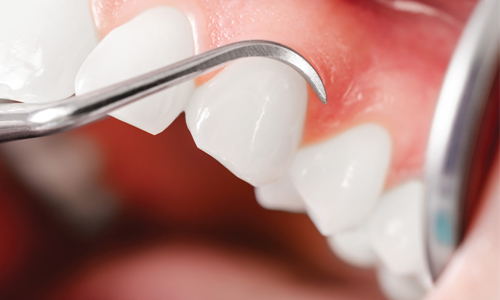INFORMATION AND APPOINTMENT FORM
Fill in the form to receive further information and request an appointment. We will call you back.
PERIODONTOLOGY

Periodontology is the specialty of dentistry that studies the soft tissues around the teeth (the cement that covers the surface of the root, the fibrous joint which is named as periodontal ligament that anchors the root of the tooth to the bone, the alveolar bone socket that surrounds the tooth, and the gum) as well as diseases and conditions that affect them.
Diseases in the tissues around the tooth may lead to the loss of a healthy tooth. Although one of the most important reasons for tooth loss is gum diseases, they are not accompanied by pain; therefore, when the patient visits the dentist, it might sometimes be too late. One of the most common beliefs is that there is no treatment for gum diseases and that the teeth will eventually be lost and that’s why they should be used as much as possible and then extracted.
Gum diseases can be treated. With this treatment, teeth can serve for a long time.
What are the reasons for periodontal diseases?
Dental Plaque:
Dental plaque is the community of microorganisms found on a tooth surface. Because it is in touch with the gum, it can create inflammation in the defense system. With oral care methods such as brushing the teeth, the main purpose is not only cleaning the food leftovers but also getting rid of this dental plaque. Due to the working system of our organism, there is a high number and variety of microorganisms in our mouths. The important thing here is to prevent the potential of microorganisms causing a disease.
Genetics:
Research has evaluated the correspondence between genetics and gum. Destruction due to lack of inflammatory response or excessive response against microorganisms in people with genetic susceptibility was shown in the research. Tooth losses in the families of people with periodontal disease generally happen due to reasons like loose teeth.
Smoking / Tobacco Use:
Tobacco use may be one of the most significant risk factors in the development and progression of periodontal disease. It also increases the risk of disease because of the changes in the person’s inflammatory response and its negative impacts on the veins. In addition, the potential of benefitting from the treatment decreases. Smoking also slows down the patient’s consultation with the dentist as it camouflages bleeding which is an early period symptom.
What’s more, some conditions and use of medication may affect the response to the treatment, its potential and severity.
- Lack of oral care
- Dental plaque
- Hormonal changes like puberty, pregnancy, and menopause
- Obesity
- Endocrine diseases such as diabetes, rheumatoid arthritis
- Weak immune system due to conditions such as poor nutrition, tiredness, stress
- Medication used
- Diseases such as leukemia, cancer, AIDS which weakens the immune system
Gingivitis:
Gingivitis is a primary gum disease. It only affects the gum. If intraoral examination is necessary in its diagnosis, radiological assessments will be sufficient.
- It’s a gum disease that causes redness and swelling of your gingiva.
- At first, there might be bleeding during teeth brushing and flossing, but later there can be bleedings spontaneously. Unfortunately, this early symptom cannot be observed in individuals who are smoking. The patients consult the dentist at a later period. Because there is no pain, the only symptom is bleeding.
You can experience bad breath that doesn’t go away.
Gingivitis is an easily treatable illness. Full recovery can be achieved without any loss in the tissues. However, if it is not treated, gingivitis can lead to much more serious gum disease called periodontitis or become chronic.
Periodontitis:
In this condition the disease goes more in depth from gingiva to tissues. It affects all the tissues that surround the tooth. While inflammation continues in gingiva, the gum detaches from the root surface and pockets are created. Tartar and plaque increase around and on the surface of the root. When it reaches the bone, destruction starts on the bone. According to the severity and amount of the destruction, tooth loss may occur. Intraoral and radiological examination must be done in the diagnosis of periodontitis.
In the determination of the amount of loss catheters with special size are used for measurement and the values are recorded as the initial value.
The symptoms of periodontitis are;
- Swelling in the gingivitis
- Redness in the gingivitis
- Sensitivity
- Bleeding
- Bad breath
- Loose teeth
- Gingival recession
- Painful chewing
- Spacing between the teeth
- Shifting of teeth
The treatment of periodontal diseases
Gingivitis
The initial thing to do is to give extensive education to the patient on oral hygiene. It is important to bring patient’s health care into an optimal level. Then good overall oral hygiene is done, and tartar and plaque are cleaned by the dentist. The treatment finishes with the polishing process. If the patient continues the dental care as shown, then the patient will fully recover.
Periodontitis
The initial thing in the treatment of periodontitis is also oral hygiene. At the second stage, like gingivitis, the surface of the teeth is cleaned. Treatment for stage two periodontal disease consists of scaling and root planing which are forms of deep cleaning that remove the deposits of tartar and plaque that are deeply rooted in your gums. The purpose of this treatment is to enable the gum to reattach to the tooth and ensure that the pocket gap is in an ideal size. After the treatment, the initial measurements are compared with the ones taken one month later. If the result is not satisfactory, the third stage starts. The patient sees the dentist at regular intervals and measurements are taken. If necessary, the dentist applies prophylaxis.
If the result is still not satisfactory, then the dentist may decide on antibiotic use or periodontal surgery is required.
Periodontal surgery:
The purpose is to decrease the amount of pocket. There are several ways of surgery.
Flap surgery:
A flap procedure cleans the roots of a tooth.
Excisional Surgery:
In this technique, if there is sufficient amount of tissue, then the tissue is removed, and pocket elimination surgery is carried out.
Bone Grafting:
It is not possible to apply this treatment to all teeth with periodontal problems. When choosing this technique, there must be suitable bone defect around the teeth. One of the most frequently done mistakes is to believe that bone can be obtained around the teeth by applying bone graft. The secret to success is doing this surgery with a correct indication.
Gingival Recession: Its Causes and Treatment
There are some certain reasons for gingival recession:
- Periodontal disease
- Misaligned teeth
- Improper tooth brushing
Clenching or grinding your teeth may cause gums to recede. Gum surgery may be required to repair the damage caused by gum recession. However, initially the cause of it must be eliminated. If the surgery is carried out before eliminating the cause, recession may reoccur.
There are many techniques available for this. Depending on the shape and size of recession and the features of the tissue, the technique is determined by the dentist.
Gingival Enlargement, Its Causes and Treatment
Causes;
- Genetic conditions
- Medications (high blood pressure medication that belong to nifedipine group, anticonvulsants, immunosuppressants)
- Hormonal states: pregnancy, puberty
- Mouth breathing
- Gingival diseases
It is important to understand the underlying cause of it clearly and plan a treatment such as paying more attention to oral hygiene, changing the medication under doctor’s control, and nose breathing according to the cause first.
Then if there are still gingival swellings, surgery can be applied to remove inflamed gum tissue.





